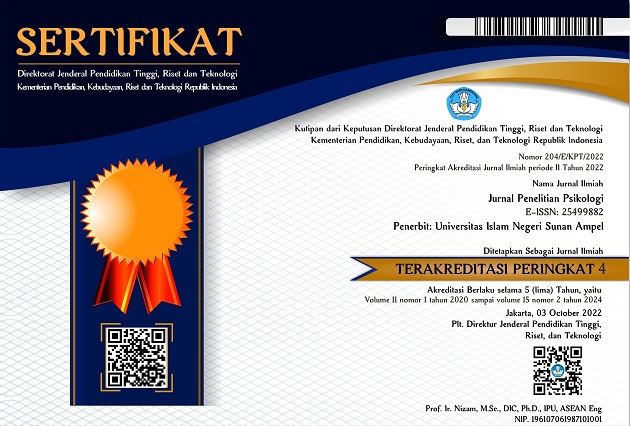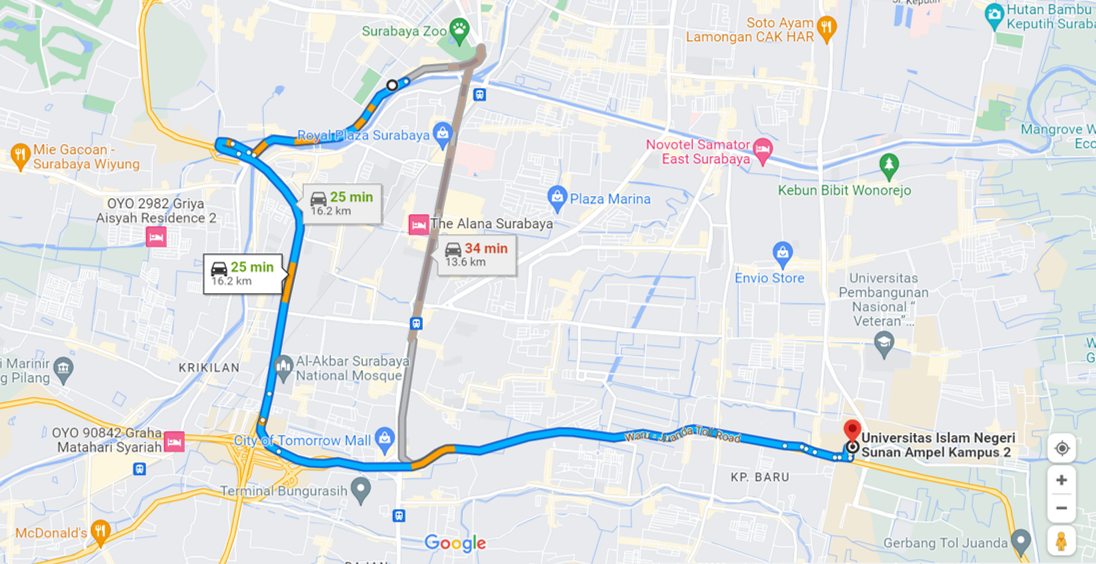Investigasi Kualitas Properti Psikometri General Health Questionnaire-28 Menggunakan Rasch Model
DOI:
https://doi.org/10.29080/jpp.v15i1.1126Keywords:
General Health Questionnaire-28, Rasch Model, Mahasiswa, Bias Gender, Properti PsikometriAbstract
General Health Questionnaire-28 (GHQ-28) adalah instrumen multidimensional yang digunakan untuk mengidentifikasi gangguan kesehatan fisik dan mental minor pada kalangan umum, seperti simptom fisik, kecemasan & insomnia, disfungsi sosial, dan depresi. Informasi yang membahas psikometri properti instrumen GHQ-28 di Indonesia masih sangat terbatas, sehingga penelitian ini bertujuan mengetahui kualitas psikometri GHQ-28 secara rinci dengan mengaplikasikan pemodelan Rasch. Desain penelitian ini menggunakan cross-sectional design. Sebanyak 283 mahasiswa strata satu yang didapatkan dengan convinience sampling berpartisipasi dalam penelitian ini. Hasil penelitian menemukan untuk empat subskala pada GHQ-28 memiliki kualitas properti psikometri yang baik serta menunjukkan dua item terindikasi bias gender. Secara umum, 26 dari 28 item dari GHQ-28 layak digunakan sebagai instrumen untuk proses skrining kesehatan mental di Indonesia. Berdasarkan hasil penelitian, dapat diimplikasikan adanya perbedaan hasil penelitian ini dengan penelitian sebelumnya, sehingga diperlukan norma yang disesuaikan dari penggunaan 26 item GHQ-28.
Downloads
References
Andrich, D. (1981). Book review: Probabilistic models for some intelligence and attainment tests (expanded edition). Applied Psychological Measurement, 5(4), 545–550. https://doi.org/10.1177/014662168100500413
Andrich, D., & Marais, I. (2019). A course in Rasch measurement theory: Measuring in the educational, social and health sciences. Springer Singapore. https://doi.org/10.1007/978-981-13-7496-8
Beck, A., Steer, R., Ball, R., & Ranieri, W. (1996). Comparison of Beck Depression 1 in Psychiatric Inventories -1A and—Outpatients. Journal of Personality Assessment, 67(3), 588–597. https://doi.org/10.1207/s15327752jpa6703
Bekkouche, N. S., Schmid, R. F., & Carliner, S. (2022). “Simmering pressure”: How systemic stress impacts graduate student mental health. Performance Improvement Quarterly, 34(4), 547–572. https://doi.org/10.1002/piq.21365
Bond, T. G., & Fox, C. M. (2015). Applying the Rasch model: Fundamental measurement in the human sciences (Third edition). Routledge, Taylor and Francis Group.
Bonilla, D., Ruperti-Lucero, E., Gavilanes-Gómez, D., Zambrano-Estrella, J., Vaca-Quintana, D., Dominguez-Lara, S., & Moreta-Herrera, R. (2021). Psychometric Properties of the General Health Questionnaire (GHQ-28) in Ecuadorian College Students. Psihologijske Teme, 30(3), 573–590. https://doi.org/10.31820/pt.30.3.9
Boroel, B., Aramburo, V., & Gonzalez, M. (2017). Development of a scale to measure attitudes toward professional values: An analysis of dimensionality using Rasch measurement. Procedia - Social and Behavioral Sciences, 237, 292–298. https://doi.org/10.1016/j.sbspro.2017.02.079
Burani, K., & Nelson, B. D. (2020). Gender differences in anxiety: The mediating role of sensitivity to unpredictable threat. International Journal of Psychophysiology, 153, 127–134. https://doi.org/10.1016/j.ijpsycho.2020.05.001
Carlsson, J. M., Mortensen, E. L., & Kastrup, M. (2005). A follow-up study of mental health and health-related quality of life in tortured refugees in multidisciplinary treatment. The Journal of Nervous and Mental Disease, 193(10), 651–657. https://doi.org/10.1097/01.nmd.0000180739.79884.10
Christensen, K. B., Makransky, G., & Horton, M. (2017). Critical values for Yen’s Q3: Identification of local dependence in the Rasch model using residual correlations. Applied Psychological Measurement, 41(3), 178–194. https://doi.org/10.1177/0146621616677520
da Rocha, N. S., Chachamovich, E., de Almeida Fleck, M. P., & Tennant, A. (2013). An introduction to Rasch analysis for Psychiatric practice and research. Journal of Psychiatric Research, 47(2), 141–148. https://doi.org/10.1016/j.jpsychires.2012.09.014
De Kock, F. S., Görgens-Ekermans, G., & Dhladhla, T. J. (2014). A confirmatory factor analysis of the General Health Questionnaire–28 in a Black South African sample. Journal of Health Psychology, 19(10), 1222–1231. https://doi.org/10.1177/1359105313488972
Duncan, P. W., Bode, R. K., Min Lai, S., & Perera, S. (2003). Rasch analysis of a new stroke-specific outcome scale: The stroke impact scale. Archives of Physical Medicine and Rehabilitation, 84(7), 950–963. https://doi.org/10.1016/S0003-9993(03)00035-2
Gallagher, A. G., O’Sullivan, G. C., Leonard, G., Bunting, B. P., & McGlade, K. J. (2014). Objective structured assessment of technical skills and checklist scales reliability compared for high stakes assessments: Reliability of OSATS assessment. ANZ Journal of Surgery, 84(7–8), 568–573. https://doi.org/10.1111/j.1445-2197.2012.06236.x
Gallagher, R. P., & Gill, A. M. (2000). National counseling center. International Association of Counseling Services, Inc.
Gibbons, P., de Arévalo, H. F., & Mónico, M. (2004). Assessment of the factor structure and reliability of the 28 item version of the General Health Questionnaire (GHQ-28) in El Salvador. International Journal of Clinical and Health Psychology, 4(2), 389–398.
Goldberg, D. P. (1978). General Health Questionnaire 28 (GHQ28). NFER-Nelson Publishing Co, Ltd.
Goldberg, D. P., & Hillier, V. F. (1979). A scaled version of the General Health Questionnaire. Psychological Medicine, 9(1), 139–145. https://doi.org/10.1017/S0033291700021644
Guo, J., Feng, X. L., Wang, X. H., & Van IJzendoorn, M. H. (2020). Coping with covid-19: Exposure to Covid-19 and negative impact on livelihood predict elevated mental health problems in Chinese adults. International Journal of Environmental Research and Public Health, 17(11), 3857. https://doi.org/10.3390/ijerph17113857
Hartini, N., Fardana, N. A., Ariana, A. D., & Wardana, N. D. (2018). Stigma toward people with mental health problems in Indonesia. Psychology Research and Behavior Management, 11, 535–541. https://doi.org/10.2147/PRBM.S175251
Holster, T. A., & Lake, J. (2016). Guessing and the Rasch model. Language Assessment Quarterly, 13(2), 124–141. https://doi.org/10.1080/15434303.2016.1160096
Iarovici, D. (2014). Mental health issues and the university student. The Johns Hopkins University Press.
Jong, C., Hodges, T. E., Royal, K. D., & Welder, R. M. (2015). Instruments to measure elementary preservice teachers’conception: An application of the Rasch rating scale model. Educational Research Quarterly, 39(1), 21–48.
Kokkinis, N., Galanaki, E., & Malikiosi-Loizos, M. (2017). Factor structure and internal consistency of the Greek version of the General Health Questionnaire – 28 (GHQ-28). Mental Health & Prevention, 7, 21–27. https://doi.org/10.1016/j.mhp.2017.07.004
Kreiner, S. (2013). The Rasch model for dichotomous items. In K. B. Christensen, S. Kreiner, & M. Mesbah (Eds.), Rasch Models in Health (pp. 5–26). John Wiley & Sons, Inc. https://doi.org/10.1002/9781118574454.ch1
Lewinsohn, P. M., Seeley, J. R., & Roberts, R. E. (1997). Center for Epidemiologic Studies Depression Scale (CES-D) as a screening instrument for depression among community-residing older adults. Psychology and Aging, 12(2), 277–287. https://doi.org/10.1037//0882-7974.12.2.277
Lisowski, P., Kantanista, A., & Bronikowski, M. (2020). Are there any differences between first grade boys and girls in physical fitness, physical activity, BMI, and sedentary behavior? Results of HCSC study. International Journal of Environmental Research and Public Health, 17(3), 1109. https://doi.org/10.3390/ijerph17031109
Lovibond, P. F., & Lovibond, S. H. (1995). The structure of negative emotional states: Comparison of the Depression Anxiety Stress Scales (DASS) with the Beck Depression and Anxiety Inventories. Behaviour Research and Therapy, 33(3), 335–343. https://doi.org/10.1016/0005-7967(94)00075-U
Mair, P. (2018). Modern psychometrics with R. Springer Science+Business Media.
Mårtensson, G., Jacobsson, J. W., & Engström, M. (2014). Mental health nursing staff’s attitudes towards mental illness: An analysis of related factors. Journal of Psychiatric and Mental Health Nursing, 21(9), 782–788. https://doi.org/10.1111/jpm.12145
Olsen, C., & George, D. M. M. S. (2004). Cross-sectional study design and data analysis. College Entrance Examination Board.
Pedrelli, P., Nyer, M., Yeung, A., Zulauf, C., & Wilens, T. (2015). College students: Mental health problems and treatment considerations. Academic Psychiatry, 39(5), 503–511. https://doi.org/10.1007/s40596-014-0205-9
Prady, S. L., Miles, J. N., Pickett, K. E., Fairley, L., Bloor, K., Gilbody, S., Kiernan, K., Mann, R., & Wright, J. (2013). The psychometric properties of the subscales of the GHQ-28 in a multi-ethnic maternal sample: Results from the Born in Bradford cohort. BMC Psychiatry, 13(1), 55. https://doi.org/10.1186/1471-244X-13-55
Puspitasari, I. M., Garnisa, I. T., Sinuraya, R. K., & Witriani, W. (2020). Perceptions, knowledge, and attitude toward mental health disorders and their treatment among student. Psychology Research and Behavior Management, 13, 845–854. https://doi.org/10.2147/PRBM.S274337
Rauschenberg, C., Schick, A., Hirjak, D., Seidler, A., Paetzold, I., Apfelbacher, C., Riedel-Heller, S. G., & Reininghaus, U. (2021). Evidence synthesis of digital interventions to mitigate the negative impact of the covid-19 pandemic on public mental health: Rapid meta-review. Journal of Medical Internet Research, 23(3), e23365. https://doi.org/10.2196/23365
Rogers, H. J., & Swaminathan, H. (1990). A Comparison of logistic regression and Mantel-Haenszel procedures for detecting differential item functioning. Applied Psychological Measurement, 17(2), 105–116. https://doi.org/10.1177/014662169301700201
Romadhona, N., Fitriyana, S., Ibnusantosa, R. G., & Respati, T. (2021). Level of depression, anxiety, and stress of college students in Indonesia during the pandemic covid-19. Global Medical and Health Communication (GMHC), 9(3), 226–232. https://doi.org/10.29313/gmhc.v9i3.8337
Roy, D., Tripathy, S., Kar, S. K., Sharma, N., Verma, S. K., & Kaushal, V. (2020). Study of knowledge, attitude, anxiety & perceived mental healthcare need in Indian population during COVID-19 pandemic. Asian Journal of Psychiatry, 51, 102083. https://doi.org/10.1016/j.ajp.2020.102083
Scott, N. W., Fayers, P. M., Aaronson, N. K., Bottomley, A., De Graeff, A., Groenvold, M., Gundy, C., Koller, M., Petersen, M. A., & Sprangers, M. A. (2010). Differential item functioning (DIF) analyses of health-related quality of life instruments using logistic regression. Health and Quality of Life Outcomes, 8(1), 81. https://doi.org/10.1186/1477-7525-8-81
Serafini, G., Parmigiani, B., Amerio, A., Aguglia, A., Sher, L., & Amore, M. (2020). The psychological impact of covid-19 on the mental health in the general population. QJM: An International Journal of Medicine, 113(8), 531–537. https://doi.org/10.1093/qjmed/hcaa201
Shayan, Z., Pourmovahed, Z., Najafipour, F., Abdoli, A. M., Mohebpour, F., & Najafipour, S. (2015). Factor structure of the General Health Questionnaire-28 (GHQ-28) from infertile women attending the Yazd Research and Clinical Center for Infertility. International Journal of Reproductive BioMedicine, 13(12), 801–808. https://doi.org/10.29252/ijrm.13.12.801
Sutanto, S., Amiruddin, D., & Nugraha, G. (2022). Rancangan bangun aplikasi skrining kesehatan mental remaja berbasis web di rumah sakit umum daerah Dr.Drajat Prawiranegara dengan metode Analytis Hierarchy Process (AHP). Journal of Innovation And Future Technology (IFTECH), 4(1), 29–38. https://doi.org/10.47080/iftech.v4i1.1813
Syafitri, D. U. (2020). Evaluasi psikometris General Health Questionnaire (GHQ) 28 pada subjek mahasiswa di Semarang, Jawa Tengah. WACANA, 12(1), 1–19. https://doi.org/10.13057/wacana.v12i1.164
Veit, C. T., & Ware, J. E. (1983). The structure of psychological distress and well-being in general populations. Journal of Consulting and Clinical Psychology, 51(5), 730–742. https://doi.org/10.1037/0022-006X.51.5.730
WHO, & Calouste Gulbenkian Foundation. (2014). Social determinant of mental health. World Health Organization.
Wicaksono, D. A., Roebianto, A., & Sumintono, B. (2021). Internal validation of the Warwick-Edinburgh Mental Wellbeing Scale: Rasch analysis in the Indonesian context. Journal of Educational, Health and Community Psychology, 10(2), 229–248. https://doi.org/10.12928/jehcp.v10i2.20260
Zhou, S.-J., Zhang, L.-G., Wang, L.-L., Guo, Z.-C., Wang, J.-Q., Chen, J.-C., Liu, M., Chen, X., & Chen, J.-X. (2020). Prevalence and socio-demographic correlates of psychological health problems in Chinese adolescents during the outbreak of COVID-19. European Child & Adolescent Psychiatry, 29(6), 749–758. https://doi.org/10.1007/s00787-020-01541-4
Zigmond, A. S., & Snaith, R. P. (1983). The Hospital Anxiety and Depression Scale. Acta Psychiatrica Scandinavica, 67(6), 361–370. https://doi.org/10.1111/j.1600-0447.1983.tb09716.x
Zile-Tamsen, C. V. (2017). Using Rasch analysis to inform rating scale development. Research in Higher Education, 58, 922–933. https://doi.org/10.1007/s11162-017-9448-0
Downloads
Published
How to Cite
Issue
Section
License
Copyright (c) 2024 Yonathan Natanael

This work is licensed under a Creative Commons Attribution-ShareAlike 4.0 International License.









